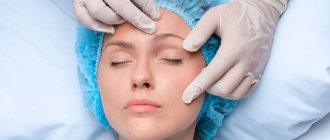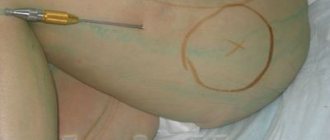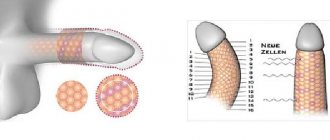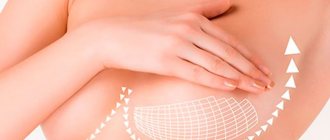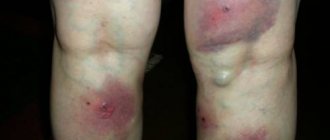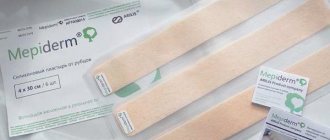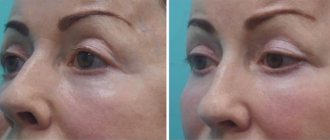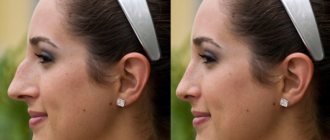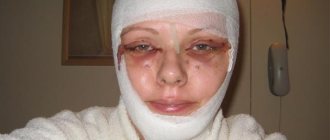Consultation with plastic surgeons with over 20 years of experience – free! Sign up by phone. Waiting for you! The impact of the environment and the internal processes of aging of the body primarily affect the condition of the delicate skin of the eyelids. Drooping of the outer corners of the eyes, ptosis of the skin of the upper eyelids form bags under the eyes. This gives the face a tired look and also inevitably adds age. Blepharoplasty of the lower eyelids may also be indicated for medical reasons due to vision problems.
Indications for lower eyelid blepharoplasty
The main indication for lower eyelid blepharoplasty is aesthetic imperfections in the eye area, which are associated with age-related changes or the patient’s heredity:
- Pronounced bags under the eyes (fatty hernias or fatty “packets”) are found even in young people;
- Excess periorbital fat;
- Wrinkles around the eyes;
- Excess skin in the lower eyelid area;
- Deep folds in the lower eyelid area and in the corners of the eyes;
- Recessions in the lower eyelids.
Any abnormal phenomena in the structure of the lower eyelids also relate to indications for lower blepharoplasty
Who is this technique indicated and contraindicated for?
What is it and who is facelift indicated for?
A facelift is a facelift; it is necessary for people over the age of 35. After 60 years, this procedure will not have such an impressive effect, so most often it is pointless to carry it out, because the skin loses its plasticity and does not accept such procedures. Indications for lower face lift :
- loss of elasticity of the skin in the area of the chin and nasolabial folds, cheeks;
- severe loss of skin plasticity;
- skin devoid of life, inelastic and too thin;
- change in facial contours.
However, this procedure has its contraindications. Therefore, you need to carefully study them before resorting to the technique. The procedure is prohibited if a person has:
- diseases of the heart and blood vessels, pathologies associated with these diseases;
- diabetes mellitus;
- the patient currently has inflammatory or infectious processes occurring in the body;
- a woman who is pregnant or breastfeeding.
Before you decide to have a lower third face lift, you need to consult with a specialist to do some tests and find out for sure whether this procedure is possible for you.
Methods of lower eyelid blepharoplasty
There are two ways to perform blepharoplasty:
- Classic lower eyelid surgery
When performing classic lower eyelid surgery, the incision is made along the natural folds, slightly away from the eyelash edge. This manipulation is necessary in order to open access to the localization of fat packets, to the orbicularis oculi muscle. Next, the surgeon delicately peels the skin away from the muscle and removes or redistributes the fatty hernias. If necessary, excess skin is excised. At the end of the operation, a cosmetic suture is placed on the incision area. During surgery, canthopexy is often performed to prevent cicatricial ectropion of the lower eyelid after blepharoplasty. This is required in particular for those patients who have a flabby eyelid edge.
The duration of the entire operation for lower eyelid blepharoplasty is about 1 hour.
Excision of the skin can also be carried out with a laser, but its use in the eye area is not recommended by many specialists
- Transconjunctival lower eyelid surgery
The transconjunctival method is most often indicated for young patients with slight excess skin of the lower eyelids. Transconjunctival blepharoplasty requires good, tight and elastic skin. The ideal patient is a young man or woman who does not have age-related changes, but has persistent and persistent bags under the eyes or swelling.
The advantage of the operation is that it is performed without an external incision. Access is through an incision or puncture in the conjunctiva of the eye. Then, excess fatty tissue is removed. No stitches are required as the mucous membrane heals very quickly. The operation also lasts about 1 hour. Read more about this technique here.
Gvaramia A.A. comments:
“Having performed eyelid surgery for more than 20 years, I can say with confidence that there is nothing better than a scalpel for this operation. I'm talking specifically about the skin incision. This is what I and most of my colleagues think. If a laser or radio knife is used, small vessels are “welded”: this is convenient for the surgeon, since the wound does not bleed. But this affects the quality of the scar! And for the best scar, I prefer a scalpel. The laser is a wonderful device, but its use must be appropriate in aesthetic medicine. Its use is justified in the transconjunctival technique, since the incision passes through the mucosa. But the final result in this case is not affected in any way by what exactly the doctor used to make the incision: it is solely a matter of the surgeon’s comfort.”
Blepharoplasty
Modern aesthetic medicine is capable of any miracles; it can help, including those people who would like to look at the world with eyes wide open. Deorientalizing blepharoplasty is performed by specialists from many plastic surgery clinics, but not all doctors can boast of extensive experience and a meticulously developed technique for performing this operation.
The surgeons at the Abrielle Clinic have both theoretical and practical knowledge, as well as an unrivaled flair for transforming ethnic eyes. Our talented specialists not only take into account the nuances of Asian eyes, they give them harmony, while emphasizing their uniqueness and beauty.
Deorientalizing eyelid rejuvenation or “Europeanization of the eyelids” is a plastic surgery whose purpose is to create a clearly defined, attractive crease of the upper eyelid, as well as to eliminate excess fat in the upper eyelid area in order to give the eyes a more open and beautiful appearance. “Sangapuri” refers to manipulations that are purely aesthetic in nature and are performed only at the request of the client.
Indications for surgery:
- Smoothness or absence of the upper eyelid fold;
- The presence of a “Mongolian” fold (epicanthus);
- Excess skin of the upper eyelid.
All doctor’s manipulations within the framework of deorientalizing blepharoplasty take from 40 minutes to an hour. Surgery is performed under local anesthesia.
Operation “Europeanization of the Century”
The specialist makes an incision where it is intended to create a new eyelid fold. He then removes fat bags, excises excess skin, and then applies sutures, while capturing deep-lying tissue.
As a result of this suturing of the edges of the wound, the skin firmly fuses with the orbicularis muscle, the muscle that lifts the upper eyelid, and the cartilaginous plate. Thus, an eye shape characteristic of Europeans is created.
If there is a need to get rid of the epicanthus, then the plastic surgeon, in addition to the actions described above, performs local Z-plasty, also called the counter-triangular flap technique. This technique is used in the area of the inner corner of the eye.
The stitches are removed after 5 days. Moderate bruising and swelling lasts for 10 to 14 days.
REVIEW OF OPERATION “EUROPEANIZATION OF THE CENTURY”
“Maybe I’m overwhelmed with emotions, it’s only the fourth day after several operations on my face (facelift, blepharoplasty, lipofilling), despite decent swelling, “tightness” and the sensation of a “foreign” face, a feeling of joy prevails. I'm sure all good things are just beginning! The good aura of the clinic, amazing selection of staff, unity, team building, high professionalism - all this in one...at the Abrielle clinic.
Thank you, low bow to you, my dears, for your beautiful hard work.
Patients who have visited this clinic once in the future, if they want to again correct something in their appearance, I am sure, will only come to the Abrielle clinic!” Tatyana, 51 years old.
The recovery period after blepharoplasty does not take much time and is painless. It is accompanied by a feeling of fullness as swelling increases - and this is only the first three days. Then the symptoms begin to subside.
To reduce the severity of edema syndrome, you can use cold compresses from chamomile decoction and often apply heparin-containing ointments or “traumeel C” to the eyelid area. 5 days after surgery, the sutures are removed. From this moment on, you can apply decorative cosmetics. It will take approximately another 7 to 10 days for the process of bruising and swelling to resolve.
Doctors also do not recommend reading, watching TV, working on a computer, or straining your eyesight in any other way during the first 2-3 days. A week after blepharoplasty, you are allowed to return to your usual work routine. You should refrain from visiting a bathhouse or sauna and playing sports for 2-3 weeks.
Plastic surgeons at the Abrielle Clinic have been helping to combat hereditary defects and signs of age for many years. They know thoroughly how to make your eyes look youthful and expressive.
We invite you to join the number of satisfied patients of the clinic who have restored their “mirrors of the soul” to a youthful and attractive appearance. Talented plastic surgeons will study in detail the anatomical features of your eyelids in order to choose the technique that will best make your eyes open and radiant.
Rehabilitation after lower eyelid blepharoplasty
Lower eyelid blepharoplasty is considered an easily tolerated operation. The very next day you will leave the clinic, but with one condition - wearing sunglasses. The sutures are removed on the 3rd, less often on the 7th day. At first, it is necessary to exclude any physical activity and prolonged work at the computer. Recovery after lower eyelid blepharoplasty at home involves treating the sutures with an antiseptic solution. The consumption of alcohol and coffee is strictly prohibited. Cosmetics can be applied after the swelling goes away, approximately 10 days.
If the operation is performed correctly, there are no complications after lower eyelid blepharoplasty.
As for the result, the final appearance can be assessed after 1.5 months. This is the period required for complete recovery. In a week, you will be able to appear in public without embarrassment and return to your normal rhythm of life. You can undergo lower eyelid surgery in our clinic. The operation is performed by a surgeon with more than 25 years of experience.
Circular facelift
A circular facelift, also called a facelift, remains by far the most effective way of rejuvenation. Only she is fully capable of coping with gravitational ptosis and returning her face to its youthful contours. This difficult operation relieves the patient of deep wrinkles, folds and a double chin, sagging skin in the forehead, eyebrows, cheeks, along the edges of the lower jaw and on the neck. It is performed after 40-45 years, the result becomes obvious two months after the operation and lasts on average for 7-10 years, depending on the individual characteristics of the body.
Plastic surgery lasts from one and a half to three hours and is performed under general anesthesia. The incisions are made under the earlobe, then lie behind the auricle and end in the scalp, at the back of the head. After peeling the skin, the surgeon selects the muscular aponeurotic layer and secures it. At the end of the circular facelift, a tight compression bandage is placed on the patient’s head, which must be worn without removal for about a week. The first two days you need to stay in the hospital under the supervision of a doctor. The stitches are removed on the tenth day. As for bruises and swelling, they go differently for everyone; on average, this process takes from two weeks to a month, after which it is already possible to give initial assessments of the operation.
The cost of a circular facelift starts from 100 thousand rubles.
From a pronounced nasolacrimal groove
The nasolacrimal groove runs from the inner corner of the eye to the zygomatic arch. When severely expressed, it adds 5-10 years to the age. Often accompanied by the presence of hernias and bruises. If you notice something like this in the mirror, don't panic. At the first signs of such a defect, the situation can be corrected using cosmetology. For example, fillers based on hyaluronic acid. A filler (dense gel) is injected into the problem area and lifts the “dip” in the area where the lower eyelid meets the cheek. The effect lasts for 9-12 months.
⇒
Preparing for surgery
Preparation for both classical and laser blepharoplasty includes a thorough examination to exclude possible contraindications and minimize risks. The operation can take several hours and is performed under general anesthesia, so any deviations from the internal organs can become a potential obstacle to its implementation.
During the initial conversation, the surgeon finds out what exactly the patient wants, determines what result is possible in his case, explains possible risks and determines the scope of the intervention. After this, the patient will have to undergo various tests and visit specialists if necessary. Many modern clinics can offer preliminary computer modeling of the result of blepharoplasty.
You can undergo examinations in advance at your place of residence, remembering that test results are valid for no more than 2 weeks. Always prescribed before surgery:
- General and biochemical blood and urine tests;
- Tests for HIV, hepatitis, syphilis;
- Determination of blood clotting;
- Fluorography;
- Electrocardiogram;
- Examination by a gynecologist with collection of cytological smears - for women.
According to indications, the patient is referred for consultations with specialized specialists - an ophthalmologist, an ENT specialist, a neurologist and others. The final decision on the safety of the operation is made by the therapist, who gives the appropriate conclusion.
After the examinations, the date of the operation is set. Two weeks before the procedure, any blood thinners, non-steroidal anti-inflammatory drugs, and vitamin E are discontinued. For women, blepharoplasty is prescribed so that it does not coincide with menstruation. On the eve of the intervention, the patient does not drink or eat in the evening in case of general anesthesia. Light sedatives may be used.
Possible complications after eyelid lift
I would like to add that it is always necessary to distinguish complications from unsuccessful operations. Among the complications, scar deformation is possible: cicatricial eversion or some other hard scarring that is characteristic of this person. This is normal, but you cannot leave a scar unattended, especially since now there are a huge number of methods for eliminating it - injections, irradiation.
The most terrible complication is retrobulbar hematoma. This is a hematoma that has gone inside and can put pressure on the optic nerve. This complication is found in the literature. To prevent the appearance of a retrobulbar hematoma, careful coagulation of blood vessels must be done during surgery, and anticoagulants should not be taken 2 weeks before surgery.
This complication is found in the literature. In addition to this, you must follow the post-operative regimen. If complications do appear, they appear on the first day after surgery and are quickly resolved in the clinic.
We recommend: How to achieve Cleopatra's look with blepharoplasty?
An external hematoma is also possible, but it is removed quickly during the rehabilitation period. All other problems relate to unsuccessful operations, among which are:
- dry eyes;
- round eyes appearing due to excess tissue removal.
Removal of increased scarring must be addressed and not left to chance. The key to a successful operation is the experience and professionalism of the surgeon who performs it. The trusted clinic has performed more than one and a half thousand eyelid correction operations. An eyelid lift is performed by qualified plastic surgeons who specialize in facial rejuvenation.
Blepharoplasty is a surgical procedure to correct the shape of the eyelids. Depending on which eyelid it was performed on, as well as the type of operation, the recovery period after rehabilitation depends.
Advantages of the EMC Clinic
Plastic surgery on the eyelids includes a number of different correction options and requires the highest qualifications and precision from the specialist. Blepharoplasty at the EMC clinic is the best plastic surgery specialists with international practice and extensive practice, mastering the most complex methods of eyelid correction.
Innovative technical equipment, a modern fully equipped operating unit, the possibility of a comprehensive examination before surgery, and a postoperative hospital allow the EMC Aesthetic Clinic to maintain the highest level of medicine in Moscow.
Contraindications
Contraindications to blepharoplasty:
- difficult to correct dry eye syndrome;
- increased intraocular pressure;
- diseases of the cardiovascular system;
- diabetes;
- blood clotting disorder;
- acute viral diseases;
- acute infectious diseases (respiratory diseases, sore throat, pneumonia, etc.).
- diseases of internal organs (liver, kidneys, circulatory and endocrine systems, blood);
- chronic diseases in the acute stage.
Classic circular blepharoplasty: surgery
Surgery is performed using general or local anesthesia. General anesthesia is used if the patient cannot tolerate local anesthesia. Many doctors agree that local anesthesia is preferable.
Because at the time of the operation, the surgeon may ask the patient to close his eyes, sit down, open his mouth - in order to correctly identify the number of tissues to be removed. In qualified clinics, classical instruments are used, since the operation is standardized. There are special tweezers with a more comfortable tip, but with specific experience you can get positive results with a basic set of tools.
In classic blepharoplasty, non-absorbable suture material is used. Absorbable suture material is not advisable for such an operation for a number of reasons. Usually the sutures from the eyelids are removed on the 3rd day after the operation, theoretically, they can be removed even the next day - the eyelids are an area where the sutures heal very quickly.
But the patient may hurt or rub his eyes, so the stitches are left in place for 3 days. Absorbable threads completely dissolve in tissues within a month.
Therefore, you should not leave a foreign body in the wound if it does not perform any function. This will lengthen the rehabilitation period, it will take additional time for the material to be absorbed, and where there is a long resorption, additional scars may form.
Some surgeons even use glue. More qualified and modern specialists prefer a couple of neat seams. The thickness of the thread resembles human hair. It is removed on the third day with one touch: simply pulled out.
Circular blepharoplasty
The extent of correction of the upper eyelids is determined at the consultation, and markings are made before the operation. The extent of correction of the lower eyelids is determined at the time of surgery. The excess skin is very thin, so it is important to excise it accurately and with precision.
If you remove a lot of tissue in the area of the upper eyelid, it will close halfway, and this is dangerous due to dry eyes and subsequent corneal transplantation. And if too much tissue is removed from the lower eyelid area, lower eyelid inversion may occur.
A round eye is another problem that occurs when the volume of excised skin is not correctly identified. Another complication is hard scarring, when the edge of the lower eyelid bends under the influence of a pulling scar - this happens rarely and is corrected with special treatment.
Therefore, it is extremely important to monitor the patient during the rehabilitation period - at least after 2 weeks, when active scarring occurs, the patient should visit the doctor to understand whether additional treatment is needed or not. Such situations are extremely rare, but it is necessary to protect yourself and take timely measures if such a situation does arise.
We recommend: What do blepharoplasty and check-lifting have in common?
Upper blepharoplasty
Upper blepharoplasty allows you to get rid of excess and overhanging skin in the upper eyelid area. The so-called “drooping eyelid” effect is not only an aesthetic defect; due to the heaviness of the eyelids, vision deteriorates over time and the eyes become more tired.
In 90% of cases, during surgery, it is also important to remove excess fatty tissue in the upper eyelid area in order to make the look more youthful and open, and the face more attractive. Plastic surgery on the eyelids involves an incision along the natural skin fold of the upper eyelids, due to which the cosmetic seam remains completely invisible.
Eyelid correction can be performed simultaneously with surgery to eliminate the congenital pathology of eyelid ptosis. To achieve the best result and visible rejuvenation, upper blepharoplasty is performed in combination with lower blepharoplasty.
Endoscopic lifting
The essence of this technology, invented in the USA, is that the facelift operation is performed not through the usual incisions, but through small entrances. The operated areas are visualized using an optical system. This operation is “younger” than a circular facelift - it can be done after reaching the age of thirty in order to minimize the first age-related changes. Endoscopic lifting is indicated for drooping eyebrows, deep wrinkles between them and on the forehead, wrinkles in the periorbital zone and a general “tired” facial expression. Using this technique, you can correct not only the entire face, but also its individual zones. Often endoscopic forehead lifting is combined with plastic surgery of the superficial muscular aponeurotic system of the middle and lower face, in which case the best cosmetic results can be expected. In general, this method is very actively used specifically for correcting age-related changes in the forehead area.
Plastic surgery is performed under general anesthesia and lasts from one to four hours. The surgeon tightens both the skin and muscles. In this case, partial or complete removal of the facial muscles responsible for the formation of wrinkles often occurs.
The rehabilitation period after endoscopic lifting is shorter than after a circular facelift; it usually takes no more than two weeks. But the need for a compression bandage is also present. The result lasts on average for five to seven years.
The cost of lifting one zone is from 120 thousand rubles.
